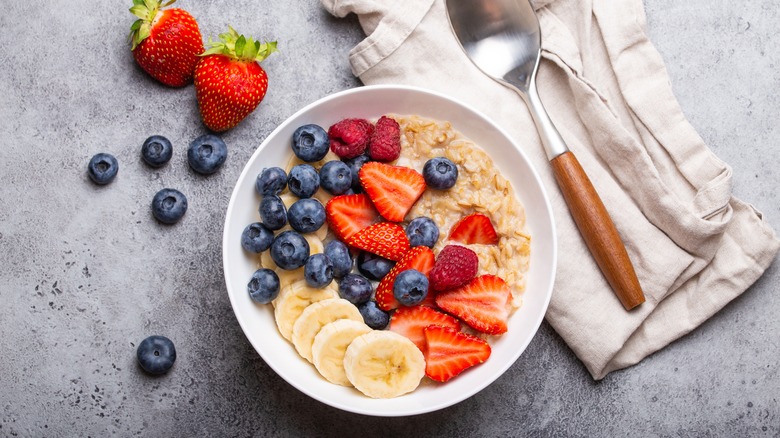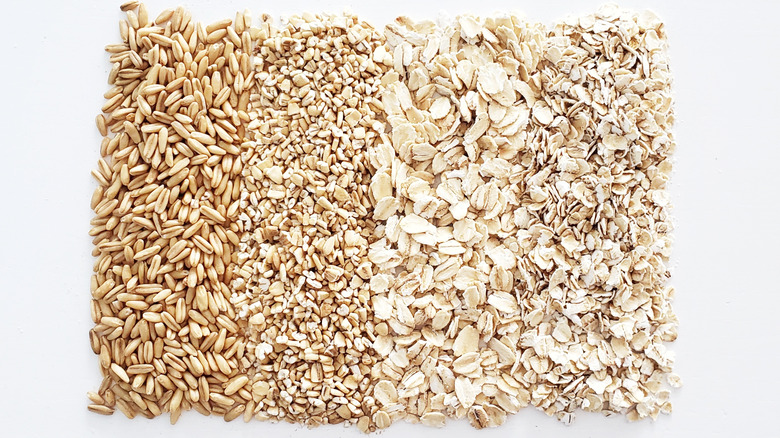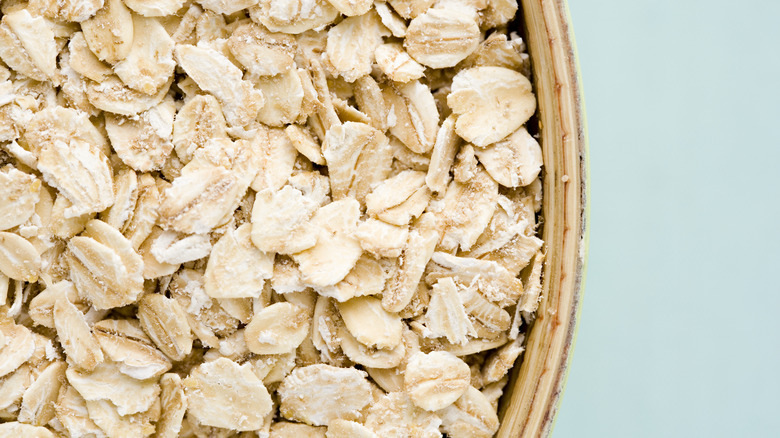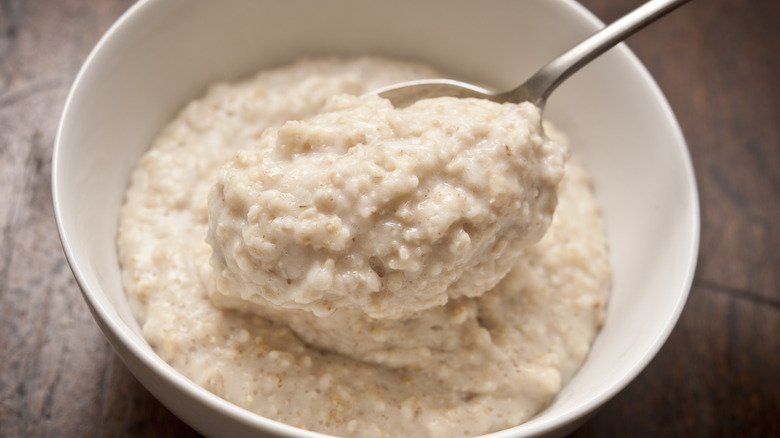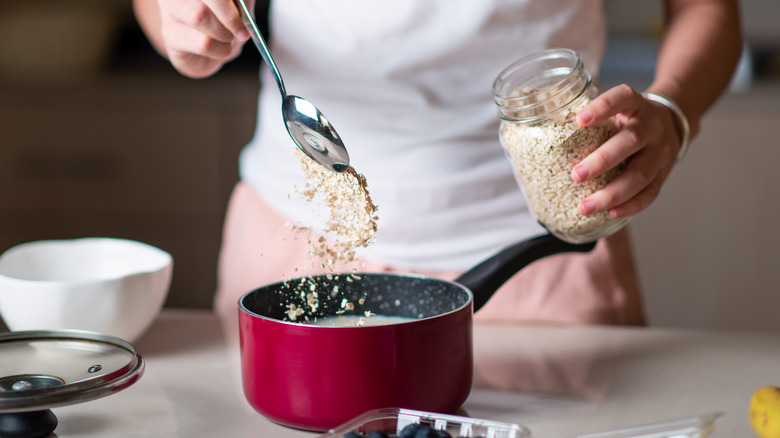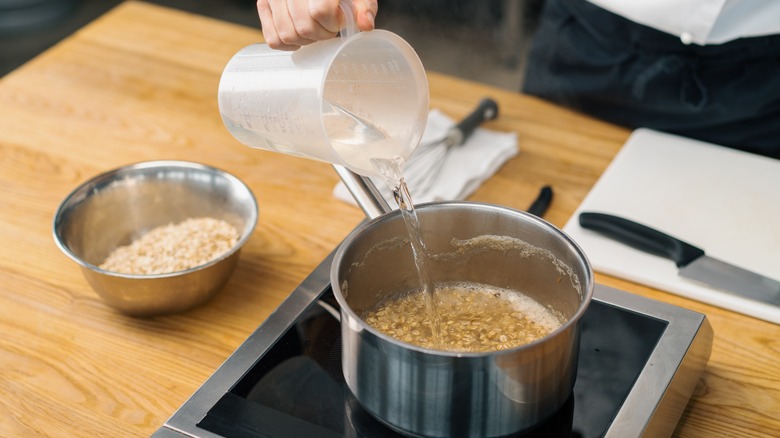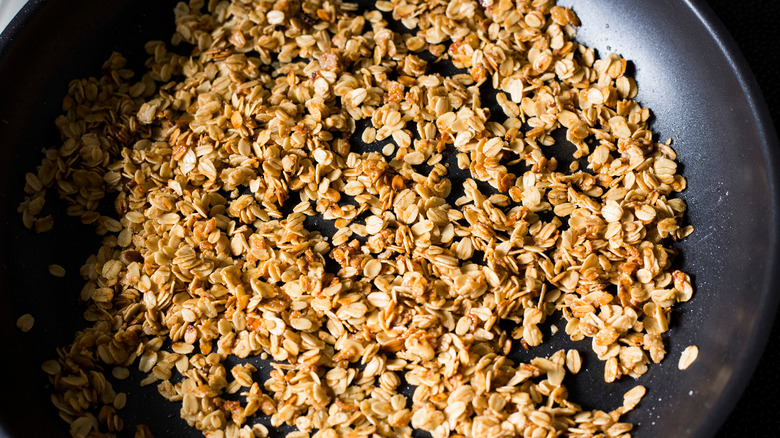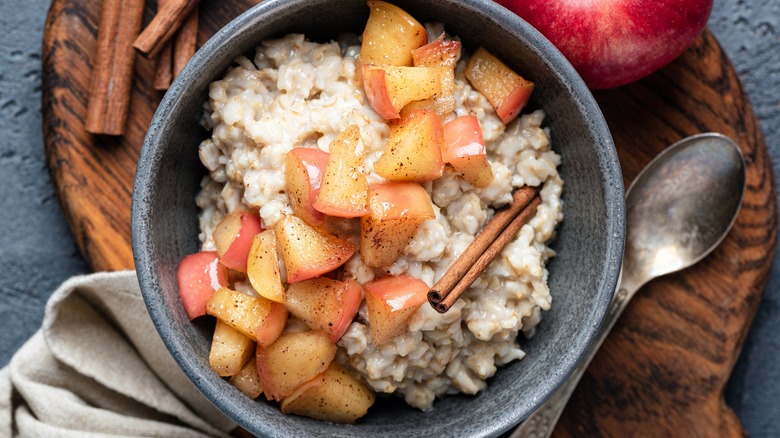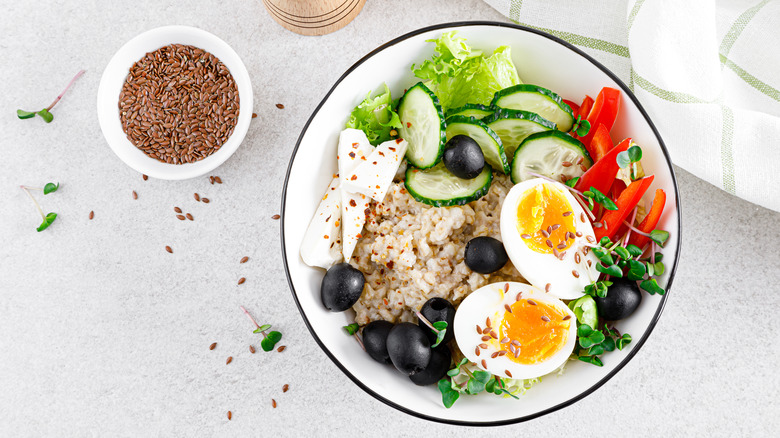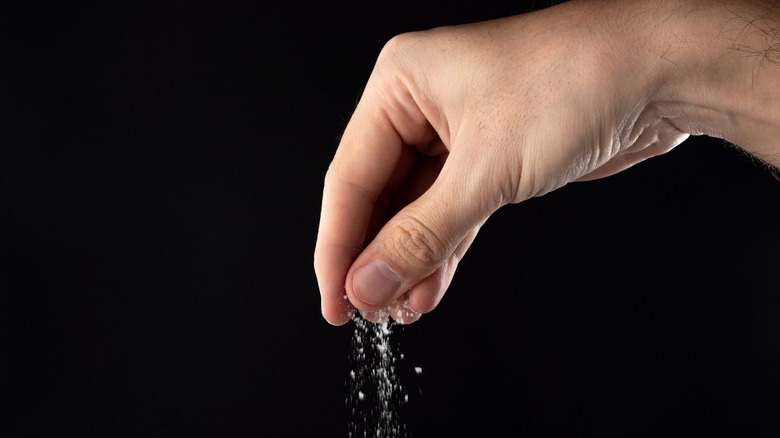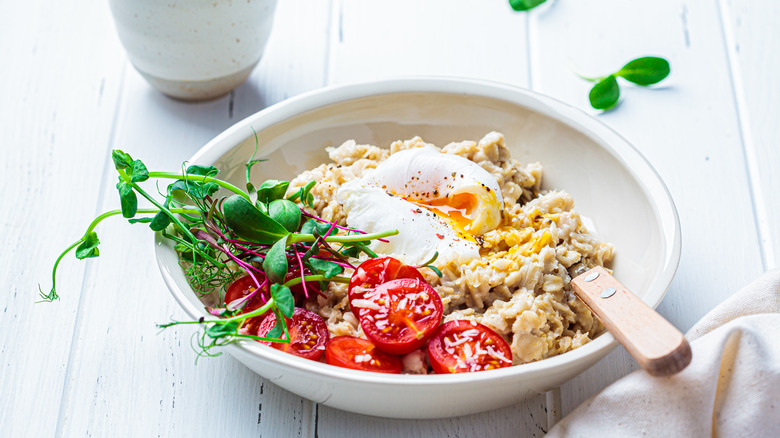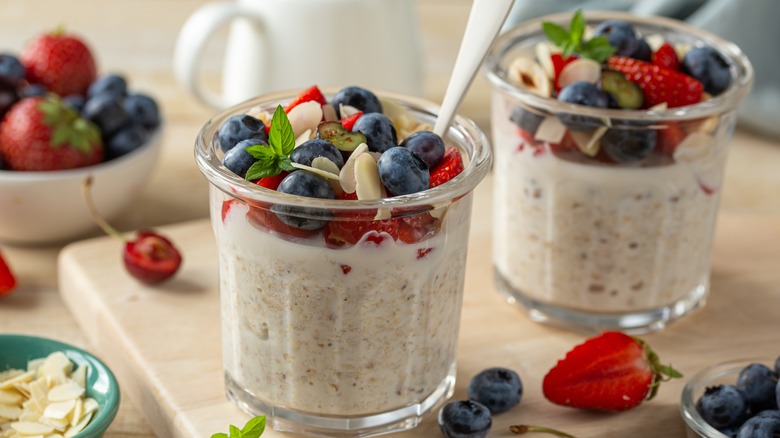Mistakes Everyone Makes With Oatmeal
We may receive a commission on purchases made from links.
For many breakfast lovers, oatmeal is No. 1 when it comes to the first meal of the day. Oatmeal may not be as sexy and exciting as your eggs benedict or your bacon, egg, and cheese bagel, and it isn't quite as mouth-watering as your pancakes and waffles (although it, too, can be smothered in syrup and butter). But it is a healthy and low-cost way to start the day. Additionally, oatmeal can be doctored up in any way you see fit. Adding everything from fresh apples to dried apricots, from chocolate chips to slivered almonds to poached eggs, and spices like cinnamon, cardamom, and nutmeg — can make oatmeal whatever you want it to be.
By knowing how to approach the actual making of oatmeal — and not always opting for the instant packets — you, too, can create a breakfast masterpiece. Understanding how to cook oatmeal, which type of oats you'll need, and which toppings will keep you fuller throughout the day will help you avoid the common pitfalls of this breakfast classic. Here are some tips on how to create the perfect bowl.
Choosing the wrong oats
There are several different kinds of oats in your local grocery store just waiting to become your morning bowl of oatmeal, your oatmeal cookies, or your quickbread. There are three main types of oats you'll likely encounter in the grocery store: instant oats, rolled oats, and steel-cut oats. Instant oats have been processed significantly, making them a good option for quick recipes like microwave oatmeal. They only need about a minute or two with a bit of hot water, and you're on your way to a nutritious meal. The flakes are thinner and have been through a pre-cooking step, so some of the nutrients and fiber have been lost.
Rolled oats — also called old-fashioned oats — are steamed and rolled flat, but not precooked like instant oats are. They require about 5-10 minutes of cooking time on the stove for traditional oatmeal; they're also the variety you'd want to use for cookies. Lastly, steel-cut oats are the least processed of the three and don't have the flat-flake look. Rather, they look rounder, like quinoa or amaranth, and, due to their lack of processing, they'll take anywhere from 15 to 30 minutes of cook time. They also make a wonderful contender for overnight oats, since the long soak time gives steel-cut oats more time to absorb liquid. They're chewier and more substantial than the other two varieties. Any of the three varieties can work for oatmeal, but it all comes down to how much time you have.
Using old oats
If you didn't need to buy new oats at the grocery store because, well, you found a container of them in the back of your pantry, you may want to double-check that expiration date. Using old oats can be not only a very subpar eating experience; it can also be a little unsafe. Like most grains, oats can expire, and there is a time when you'll need to cut your losses and throw them out.
First, if you've discovered an old-ish box or container of oats that shows signs of insects, moisture, mold, or discoloration, you need to toss it. Any of those signs could lead to sickness and allergic reactions; not worth it for a fairly cheap pantry staple. If your oats are past their expiration date but they look and smell fine, you're probably okay to use them. But you should toss them within a reasonable amount of time — most can last a total of about two years if they're unflavored and steamed or processed (so rolled oats may have a better chance than steel cut). They may taste a bit odd, as the fats within the oats will start to get stale and may even sour a bit. Use your judgment, but don't be afraid to say "never mind" to that oatmeal breakfast until you have some fresh oats in hand.
Wrong liquid to oatmeal ratios
Once you have your preferred oats in hand, you can start exploring how to create your perfect bowl of oatmeal. Maybe you're craving an autumnal bowl of apple cinnamon steel-cut oats, or a savory version with an egg poached over cheesy oatmeal instead of grits. Regardless of what you're looking to make, a cardinal mistake would be overlooking the ratio of liquid needed to cook your particular type of oats.
If you're going for the microwave method — arguably the quickest and most efficient for the mornings you're either being forced to commute to the office or get up late for a one-on-one Teams meeting with your boss — you'll need to adhere to a one-to-one ratio of liquid to oats. The best oats for the microwave are rolled oats, so pour a cup or so into a bowl, add your liquid (water, milk, half and half, or a combination), and nuke on high for about a minute and a half. Stir, then microwave for an additional minute or until you've hit the desired thickness.
If you've got a little more time and have decided to cook your oats stovetop style, the ratio changes from one-to-one to two-to-one. Boil your liquid first, then add your oats, reduce heat, and simmer for about five minutes or until the liquid is absorbed, the oats are cooked, and your oatmeal is at prime thickness.
Using only water
On the subject of liquid-to-oat ratios, we would be remiss if we didn't mention the choice of liquid(s) for cooking your oatmeal. If you're going the instant packet microwave route, using milk — either dairy or plant-based — can lead to a creamy, more luscious bowl of oats.
However, if you're going for the stovetop method it's best to stick with water. You should never actually cook your oatmeal in milk on the stove as it can lead to your oatmeal becoming sticky, gluey, and overall a weird, spongey texture. Of course, there's an in-between here we can get behind: If you are going to cook your oats on the stovetop, we'd recommend starting with water and then adding milk once things are simmering. You could also opt for half water, half milk, and just play with ratios in terms of creaminess to see what you personally like. Plant milk tends to be more watery than regular dairy milk, so there may be a happy medium there, too. It's up to your taste preference. We just wouldn't recommend making your oatmeal with only water and then thinning it out with more water. Milk will add creaminess, body, and protein.
Cooking in the wrong vessel
Stovetop and microwave methods seem to be the most tried and true for making a big bowl of stick-to-your-ribs oats. Even overnight oats in their Mason jars are a go-to option for those not wanting to actively cook, well, anything on a weekday morning. But skipping the use of a slow cooker or even a rice cooker to make your morning oatmeal could be a big mistake — especially if you're making more than one serving.
If you have a rice cooker, set it to the "white rice" setting and add your liquid and rolled oats as directed. Steel-cut oats would take longer, so opt for the rolled variety here. Cook for about 20 minutes — no need to stand over and stir or watch for boiling over. You can try steel-cut oats here if your rice cooker has a "porridge" setting, but you'd need to cook for closer to 30 minutes.
Slow cookers and Instant Pots have their options when it comes to oatmeal, too. Make oatmeal in your slow cooker the night before by going for a ratio of one cup of rolled oats to three cups of water. Cook for about 6 to 8 hours without stirring and, when it's the consistency you like, add in your cream or milk, brown sugar, and toppings. This is great for a crowd as it can easily be doubled and even tripled. It can also be left plain and you can allow your guests to customize it as they please.
Not toasting your oats
There are ways to upgrade your oatmeal before you even begin the process of adding milk, water, and/or spices. Many folks swear by toasting their rolled or steel-cut oats first. Thanks to the Maillard reaction — the thing that makes toast, well, toast, or helps steak get that beautiful sear on the outside while it's cooking in cast iron — toasting up your oats in a dry pan can greatly enhance their flavor. Simply add your rolled or steel-cut oats (this won't work with instant) to a pan and toast on your stovetop over medium heat until you can smell a toastiness. Unlike when you're toasting nuts, you won't notice much of a color change. The whole process should take about five minutes, and don't worry — you aren't at risk of burning the oats.
Once they're done, cook the oats as you would for making your oatmeal. You'll notice a warm, toasty, savoriness that was otherwise missing with non-toasted oats. So, if you have five extra minutes, this is a step worth the hassle.
Adding too much sugar
Oatmeal traditionally is made to be on the sweeter side. Cinnamon and brown sugar; maple; apple cinnamon; peaches and cream — most if not all of the popular varieties of instant packets highlight fruit and spices for a sugary breakfast, but adding too much sugar to your morning oatmeal could undo the healthy qualities of the dish you're creating. If you're making oatmeal on the stove, adding a bit of brown sugar, maple syrup, molasses, honey, or agave can go a long way. But if you've added that and then plan to add additional mix-ins like jams, dried fruit, chocolate chips, jellies, and fruit, you could have a bit of a sugar bomb on your hands.
In the interest of health and not setting yourself up for a sugar crash later, make your oatmeal without any additional sweeteners until it's off the stove and done. Then, add one sweet item at a time — a cut-up banana, a drizzle of honey, a handful of chocolate chips. Taste after each addition, and when it's reached a reasonable level of sweetness for you, let your additional add-ins be sugar-free: nuts, seeds, etc.
Skimping on protein
Oatmeal is a great opportunity to customize your breakfast, and doing so should include adding some necessary protein to start your day. Many folks take this quite literally, adding protein powder to their oatmeal. While that's well and good, there are plenty of other ways to start your day right with a protein-packed bowl of oatmeal.
Nut butters like those made from almonds, macadamia, and peanuts all offer a good amount of protein while also adding a creamy textural element to your oatmeal. They also mix in easily to a bowl of hot oatmeal or a jar of overnight oats. Other sources of protein are whole or chopped nuts, chia seeds, and yogurt. Just keep an eye on how many add-ins you're putting into your bowl; those calories add up quickly. Other great sources of protein steer toward the savory. Adding a poached egg, slices of avocado, lox, and even some cheeses can help you avoid the morning sugar-bomb trap and, instead, tide you over till lunch with ease.
Not adding a little salt
Whether you've chosen the savory route or the sweet, your oatmeal can and will benefit from the addition of a little salt. As with most anything, salt serves to enhance the flavor of items already present. It'll make the oats taste a bit nuttier; enhance any spices — like cinnamon, nutmeg, or ginger — you've added to your oatmeal; and elevate flavors like vanilla and maple syrup. As far as how much to add, if you've gone the stovetop route, add a pinch or so of kosher salt to the water before you add your oats — the same as you'd do for pasta.
If you forget to add salt at the beginning of your cooking time, or you've gone the way of the microwave, you can also opt to add a little sodium a la salted butter just before serving. Finishing your oatmeal off with the slab of cold, good-quality butter does a few things: first, the salt present in the butter will enhance the spices, fruit, and sugar you've added. Second, the butter itself, a fat, will add a creamy, luxurious mouthfeel to your bowl of oatmeal. Third, the added fat will help keep you feeling fuller for longer. All in all, adding a little salt and or butter has the potential to take your oatmeal from good to great.
Skipping savory options
In the same vein of not missing out on salt or protein in your oatmeal, you could go all the way and take those oats into grits territory; making them a savory breakfast instead of a sweet one. We know it may feel a little odd, but recipes abound for savory oats — from savory Nordic oatmeal featuring sausage, beans, and eggs to a take on shrimp and grits with sharp cheddar cheese, it's worth exploring the world of a salty over sweet breakfast bowl.
If you're feeling a little unsure about the whole sweet oats situation, start with a stovetop bowl of steel-cut oats, which feel a little more rustic and grain-like than the rolled variety. Cook in water, add your salt and — instead of spices, opt for some good cracked black pepper. Add in a bit of cream or milk, then, off the heat, mix in some shredded cheese of your choice and a dollop or two of butter. From there, top off with a fried egg, crumbles of bacon, and a few slices of avocado, if you're feeling fancy. You'll be surprised at just how approachable a savory bowl of oatmeal can be. Plus, it'll give you another option if you just aren't feeling the sweetest in the morning.
Ruling out serving your oats cold
Making your oatmeal on the stove or in the microwave is the traditional way to go. But within the last few years, overnight oats have become all the rage, and — as it turns out — cold oatmeal isn't as bad as it sounds. Goldilocks, eat your heart out. If you're more of a meal prep person rather than a run-around-in-the-morning person, overnight oats could be the best option for you.
Like its hot cousin, overnight oats are extremely versatile and can be customized to suit your favorite tastes and flavors. Start with a clean jar — even an almost empty peanut butter or almond butter container can work — and measure in oats and liquid in a one-to-one ratio. Here, you can start with milk, and using liquid like milk, almond milk, half-and-half, coconut milk, and even buttermilk simply adds to the flavor and won't give you the dreaded gluey texture that cooking the oats in it would do. After adding your oats and milk of choice, you can add in any number of mix-ins from chia seeds to jams to nuts. You can also add in a tablespoon (or less) of a sweetener like honey, agave, or maple syrup. Mix everything, then let it sit in the fridge overnight (ideally about 8 hours). Before enjoying the next morning, you can add fresh fruit and any other toppings you desire. Just keep in mind the amount of sugar and calories you're adding, too.
Ordering to-go or fast food oatmeal
It could be that you're totally in the mood for oatmeal but either has no oats at home or just can't find the time to make your very own, special bowl. Many fast-food chains do offer oatmeal, but it may be better left as a special treat rather than a regular morning routine.
Take McDonald's oatmeal, for example. The fast food giant boasts a fruit and maple oatmeal clocking in at about 320 calories for a bowl that features apples, two kinds of raisins, maple syrup, brown sugar, and heavy cream. Although that calorie count doesn't sound too bad, it's the 33 grams of sugar that are the trouble here. The addition of so much dried fruit, plus the apples, sugar, and maple syrup, make this a bit of a sugar bomb, even if the calories aren't terrible. For reference, a full-size Snickers bar has about 20 grams of sugar. The oats here are also lower in protein, although they are high in fiber. So, yes, as a treat or if time simply wasn't on your side, a fast food oatmeal bowl isn't the worst thing ever. But a little planning ahead and control over the sugar and fat content in your homemade batch is the better choice when it comes to morning oatmeal.
